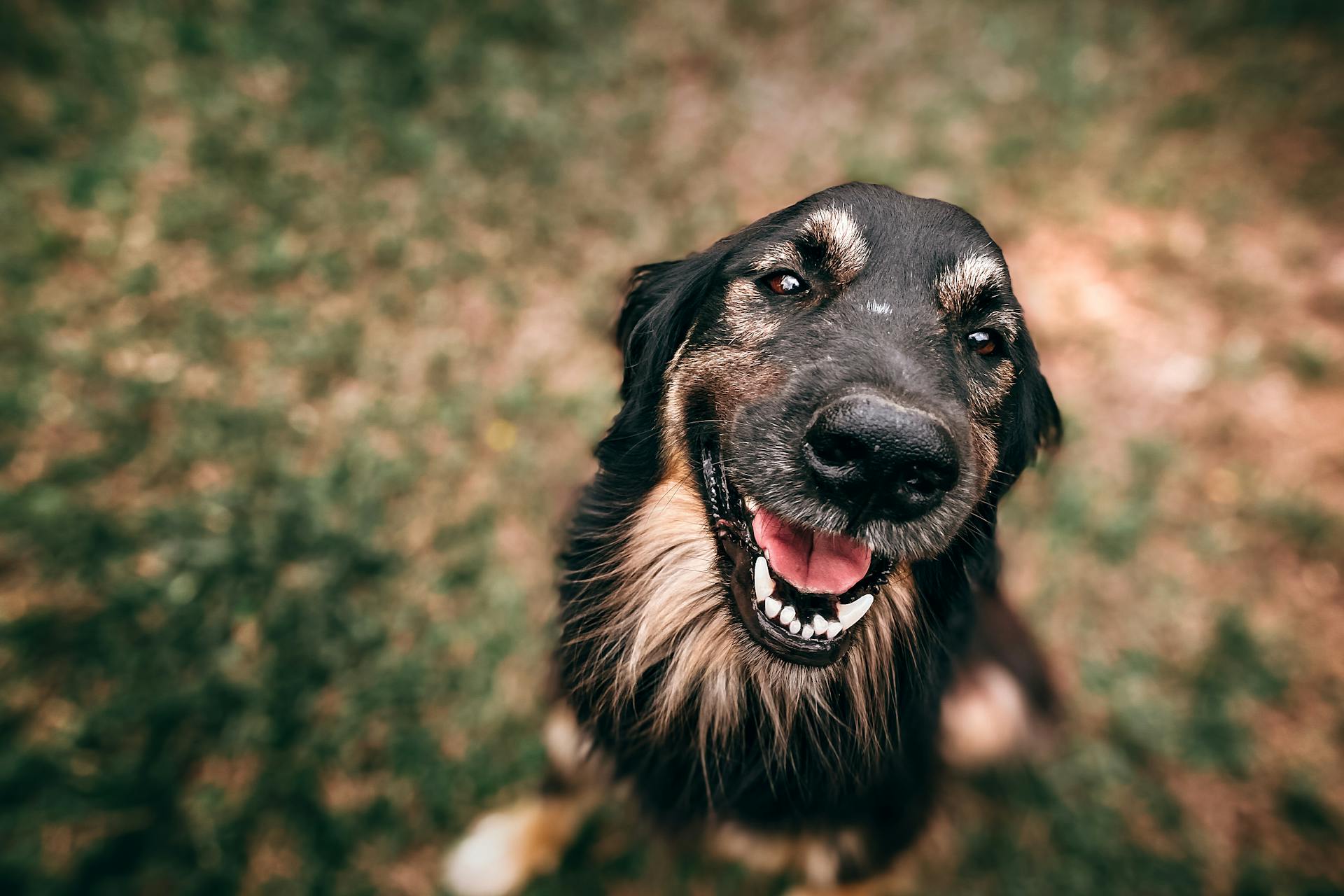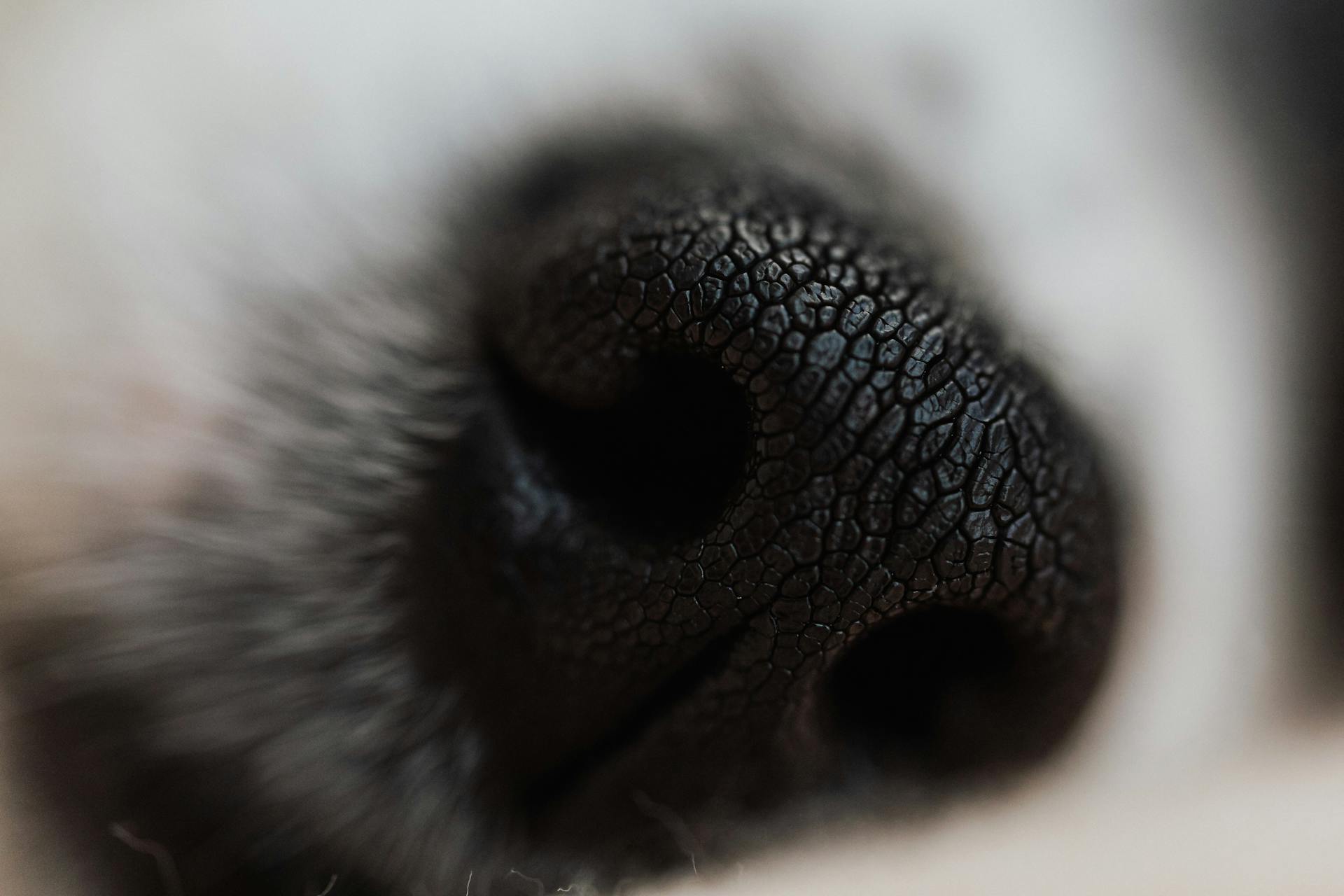
Dog cysts can be a concerning issue for pet owners, but understanding the different types and what to expect can help you feel more in control. The most common types of dog cysts include sebaceous cysts, which are usually found on the skin and are caused by a blockage of the sebaceous glands.
Sebaceous cysts can be diagnosed through a physical examination and may require a biopsy to confirm the diagnosis. Treatment typically involves draining the cyst and preventing it from becoming infected.
Home care tips for dog cysts include keeping the affected area clean and dry, applying a topical antibiotic ointment, and monitoring for signs of infection.
What is a Cyst?
A sebaceous cyst is a small, raised bump that appears on or beneath a dog's skin, usually solitary but sometimes multiple, and can range in size from a quarter of an inch to two inches wide.
Sebaceous cysts are often smooth in appearance with a white or bluish color.
They can sometimes have hair coming out of them because of neighboring hair follicles.
Sebaceous cysts can excrete discharge that is light grey or white in color, or have a cottage-cheese appearance.
There usually isn't a bad smell associated with a ruptured cyst unless it has become infected by bacteria.
Check this out: Curly Hair Dog Types
Types of Dog Cysts
There are several types of dog cysts, each with its own unique characteristics. A false cyst is a fluid-filled structure that doesn't contain a secretory lining, and can form secondary to trauma.
Some common types of false cysts include hematomas and seromas. Hematomas are a type of false cyst that can develop in the pinnae of a dog's ear, often as a result of an ear infection. Seromas, on the other hand, can form following surgery and are characterized by the accumulation of serum between tissue layers.
True cysts, on the other hand, are lumps that contain accumulated fluid secreted by cells within their lining. These types of cysts can vary in size and are usually soft due to the accumulated fluid.
Recommended read: Dog Ear Types
Interdigital cysts are a type of cyst that develops on a dog's paw between their toes. These cysts are typically firm and not easily moveable, and can become irritated and inflamed due to a dog's frequent licking.
Some breeds are more prone to developing sebaceous cysts, including Boxers, Shih Tzus, Basset Hounds, Schnauzers, Yorkshire Terriers, and Doberman Pinschers.
What Are?
Sebaceous cysts are a common skin growth in dogs, and they originate from the sebaceous glands that adjoin the hair follicles. These glands produce an oily secretion called sebum, which can become trapped and form a cyst.
Sebaceous cysts can develop anywhere on a dog's body, but they're most commonly found on the head, legs, chest, and neck. They can be light or dark in color.
Some breeds are more prone to developing sebaceous cysts, including Boxers, Shih Tzus, Basset Hounds, Schnauzers, Yorkshire Terriers, and Doberman Pinschers.
Sebaceous cysts can be treated with warm compresses and antibiotics, or in some cases, surgically removing the cyst.
Follicular cysts occur within hair follicles and can cause a dilation of the follicle. They can occur anywhere on the body, but are most common in areas with pressure points and friction.
Follicular cysts can rupture into surrounding tissues or out of the cyst, causing inflammation and further irritation.
Here are some breeds that are more prone to follicular cysts:
- Some breeds of hounds
- Hairless dogs
The range of treatment for follicular cysts is the same as sebaceous cysts in dogs, and can include warm compresses, antibiotics, and surgical removal.
Interdigital Cyst
Interdigital cysts are typically found on a dog's paw between their toes, and they're usually firm and not easily moveable.
They're small to medium in size and can become irritated and inflamed because dogs frequently lick them.
Interdigital cysts may also bleed or ooze thin, clear-to-yellow fluid.
These cysts are benign, but they can be painful for dogs depending on the cyst's size and location on the paw.
Interdigital cysts tend to be associated with infections.
Causes and Risk Factors
Trauma or injuries to the skin can increase the risk of cyst formation in dogs. This is because damage to the skin can lead to blockages in follicles or skin pores.
UV ray damage from the sunlight is another factor that may contribute to cyst development. Prolonged exposure to the sun's rays can cause skin damage and increase the risk of cysts.
Inflammation or infection can also lead to cyst formation in dogs. This is because inflammation can cause blockages in follicles or skin pores, leading to the accumulation of dead skin cells and secreted glandular materials.
Scar tissue accumulation is another risk factor for cysts in dogs. As scar tissue builds up, it can cause blockages in follicles or skin pores, leading to cyst formation.
Some breeds are more prone to cysts due to genetic predisposition. Cocker Spaniels, Boxers, Golden Retrievers, and Schnauzers are especially common breeds that can develop cysts.
Here are some factors that may increase the risk of cyst formation in dogs:
- Trauma or injuries to the skin
- UV ray damage from the sunlight
- Inflammation or infection
- Scar tissue accumulation
- Hair follicle inactivity in hairless breeds
Diagnosis and Treatment
To diagnose the type of cyst your dog has, a veterinarian will first complete a physical exam and note defining characteristics, such as size and location, of the lump.
A small sample is taken using a needle and viewed under a microscope to determine the type of cyst. Bloodwork may be done to assess the dog's overall health, and the sample can be sent to a pathologist for additional testing and review.
If a cyst warrants treatment, possible options include topical or oral medications, draining of fluid, and surgery. Medications may include antibiotics or anti-inflammatory medications, particularly if a bacterial infection occurs.
Broaden your view: What Type of Dog Is Marmaduke?
How Will My Vet Diagnose a Cyst?
A veterinarian will first complete a physical exam to note defining characteristics of the lump, such as size and location. They'll also take a small sample using a needle to view under a microscope.
Many lumps and bumps can look the same, so it's essential to inform your vet about any new lumps you find. This allows them to perform additional testing to determine the type of mass.
A fine needle aspiration (FNA) test may be recommended to collect material and/or cells within the mass. This is useful for a wide variety of skin tumors, such as mast cell tumors or subcutaneous tumors.
In some cases, the aspirate may only yield normal skin cells, inflammatory cells, or cellular debris, especially for smaller or firm skin cysts like sebaceous cysts.
Bloodwork may be done to assess the dog's overall health, depending on the type of treatment recommended. This helps ensure the vet offers the most effective treatment option.
Related reading: Dog Skin Diseases Pictures
Treating
Treating cysts on dogs can be a straightforward process, especially if caught early. If your vet determines that treatment is necessary, possible options include topical or oral medications, draining of fluid, and surgery.
Some cysts may not require treatment at all, but if they do, antibiotics or anti-inflammatory medications may be prescribed to address any bacterial infections or inflammation.
Medications won't solve the problem forever, though - draining the cyst is often a temporary solution, and the cyst will eventually refill.

Surgical removal is usually recommended for cysts that are unresponsive to other treatment options or that continue to refill. This surgery typically involves removing the outer layer and all enclosed material under general anesthesia.
Dogs usually tolerate cyst removal surgery and recovery well, and pain medication is usually prescribed to be given at home.
Check this out: Types of Dog Knee Surgery
Specific Cyst Types
There are several specific types of dog cysts, each with its own unique characteristics.
Sebaceous cysts are one of the most common types of dog cysts, often found on the face, neck, and near the base of the tail. They can be unsightly and cause discomfort for the dog, but are usually harmless.
Infected sebaceous cysts can become abscesses, which are painful and require veterinary attention.
True Cyst
True cysts on dogs can vary in size and are usually soft due to the accumulated fluid they contain.
They can be found near the eyelid or ear, and are often translucent or dark-colored with a secretory layer.

These cysts are usually caused by blocked ducts in the skin, which can lead to the formation of a fluid-filled or solid lump.
A vet will typically remove a true cyst by removing the gland and secretory lining to prevent it from coming back.
True cysts can appear clear and resemble a vesicle, often containing a watery fluid.
They tend to occur on the neck, head, and back, and can be a common issue in both dogs and cats.
If punctured, true cysts can leak fluid, which may dry and form crusts on the surrounding fur.
False Cyst
A false cyst is a fluid-filled structure that doesn't contain a secretory lining.
These cysts can form secondary to trauma, such as ear infections in dogs or injuries along the rib cage. Aural hematomas, for example, are common in dogs and occur when blood accumulates in the pinnae of the ear.
False cysts can also form following surgery, like seromas, which are the accumulation of serum between tissue layers. Seromas are similar to hematomas but contain the portion of blood without red blood cells.
False cysts will often resolve on their own, but if very large or painful, intervention may be needed. Draining and treating the traumatized skin usually prevents false cysts from returning.
Expand your knowledge: Dog Ear Types Chart
Follicular Cyst
Follicular cysts occur within hair follicles and can cause a dilation of the follicle. They can occur anywhere on the body, but pressure points and areas with friction are the most prone.
Follicular cysts can contain fluid or dark, thick secretions that can contain keratin. Interdigital cysts, which occur between toes, are correlated to allergies, and treating allergies can often benefit the patient.
Cysts can rupture into the surrounding tissues or out of the cyst, causing inflammation and further irritation. They can also become infected, often due to self-trauma.
Follicular cysts on dogs occur at the hair follicle when they become blocked, usually from trauma or pressure. Some breeds of hounds and hairless dogs are more prone to follicular cysts.
The range of treatment for a dog hair follicle cyst is the same as sebaceous cysts in dogs.
Dermoid Cyst
Dermoid cysts on dogs are rare and mostly seen in breeds like Rhodesian Ridgebacks.
They're formed during a puppy's development in the womb from an incomplete closure of the epidermis layer of the skin.
Dermoid cysts can be complicated to treat, often requiring surgery for removal.
Imaging may be used to help diagnose them, and in some cases, a referral to a specialist is necessary.
Dermoid cysts that involve the spinal cord may require a specialist's removal or tying off.
It's always best to schedule a vet appointment if you notice a growth on your dog, even if you think it's a false cyst.
A vet can confirm whether the growth is a cyst and give you peace of mind as a dog owner.
Suggestion: Vets Dog Treats
Frequently Asked Questions
What does a cyst look like on a female dog?
A cyst on a female dog typically appears as a single, round, hard nodule on or under the skin, often with a bluish color. It may contain a thick, yellowish or grey cheesy material that can become infected and produce a foul smell.
How do you get rid of a cyst on a dog?
To remove a cyst on a dog, a veterinarian may use a surgical incision or a laser to cut it out. Laser removal is often preferred, especially for multiple cysts, and is commonly used by veterinary dermatology specialists.
What does a cancerous cyst look like on a dog?
A cancerous cyst on a dog typically appears as a raised, firm lump or wart-like patch, often found on the head, legs, rear, or abdomen. If you suspect a lump on your dog, consult a veterinarian for a proper diagnosis and treatment.
Sources
- https://www.dogster.com/ask-the-vet/types-of-cysts-on-dogs
- https://www.greatpetcare.com/dog-health/types-of-cysts-on-dogs/
- https://www.theultimateleash.com/blogs/types-of-cysts-on-dogs-and-how-to-treat-them-by-kristina-lotz-dogster-com/
- https://toegrips.com/sebaceous-cyst-dog/
- https://www.springhouseanimalhospital.com/site/blog/2021/11/18/tumors-in-dogs
Featured Images: pexels.com


